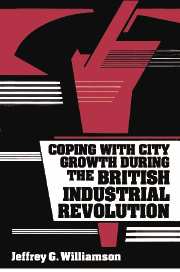Book contents
- Frontmatter
- Contents
- List of tables
- List of figures
- Acknowledgments
- 1 Coping with city growth, past and present
- 2 The urban demographic transition: Births, deaths, and immigration
- 3 Migrant selectivity, brain drain, and human capital transfers
- 4 The demand for labor and immigrant absorption off the farm
- 5 Absorbing the city immigrants
- 6 The impact of the Irish on British labor markets
- 7 Did British labor markets fail during the industrial revolution?
- 8 Did Britain's cities grow too fast?
- 9 City housing, density, disamenities, and death
- 10 Did Britain underinvest in its cities?
- References
- Index
1 - Coping with city growth, past and present
Published online by Cambridge University Press: 03 May 2010
- Frontmatter
- Contents
- List of tables
- List of figures
- Acknowledgments
- 1 Coping with city growth, past and present
- 2 The urban demographic transition: Births, deaths, and immigration
- 3 Migrant selectivity, brain drain, and human capital transfers
- 4 The demand for labor and immigrant absorption off the farm
- 5 Absorbing the city immigrants
- 6 The impact of the Irish on British labor markets
- 7 Did British labor markets fail during the industrial revolution?
- 8 Did Britain's cities grow too fast?
- 9 City housing, density, disamenities, and death
- 10 Did Britain underinvest in its cities?
- References
- Index
Summary
Looking backward from the present
The past quarter century witnessed unprecedented economic progress in the Third World as gauged by the standards of the First Industrial Revolution. Economic success of that magnitude has always created problems of dislocation and structural adjustment. City growth is one such problem, and given the unprecedented progress in the Third World, their city growth problems seem, at least to those who ignore history, unprecedented as well. By the end of this century, the United Nations forecasts urban population growth rates three times those of rural areas. Two billion people, exceeding 40 percent of the Third World population, will live in cities; some cities will have reached extremely large size – Mexico City at 31.6 million, São Paulo at 26 million, and Cairo, Jakarta, Seoul, and Karachi, each exceeding 15 million. Current rates of Third World city growth border on the spectacular, averaging between 4 and 5 percent per annum.
Analysts and policymakers are sharply divided on the city-growth problem. Pessimists stress the Third World's inability to cope with the social overhead requirements of rapid urban growth and high urban densities, citing ugly squatter settlements, pollution, environmental decay, and planning failure as evidence of their inability to cope. Third World city growth is viewed by the pessimists as another example of the “tragedy of the commons,” a classic example of overuse of a collective resource. In contrast, optimists view city growth as a central force raising average living standards. They view urbanization as the natural outcome of economic development, and a requisite for the more rational use of economic resources.
- Type
- Chapter
- Information
- Publisher: Cambridge University PressPrint publication year: 1990



